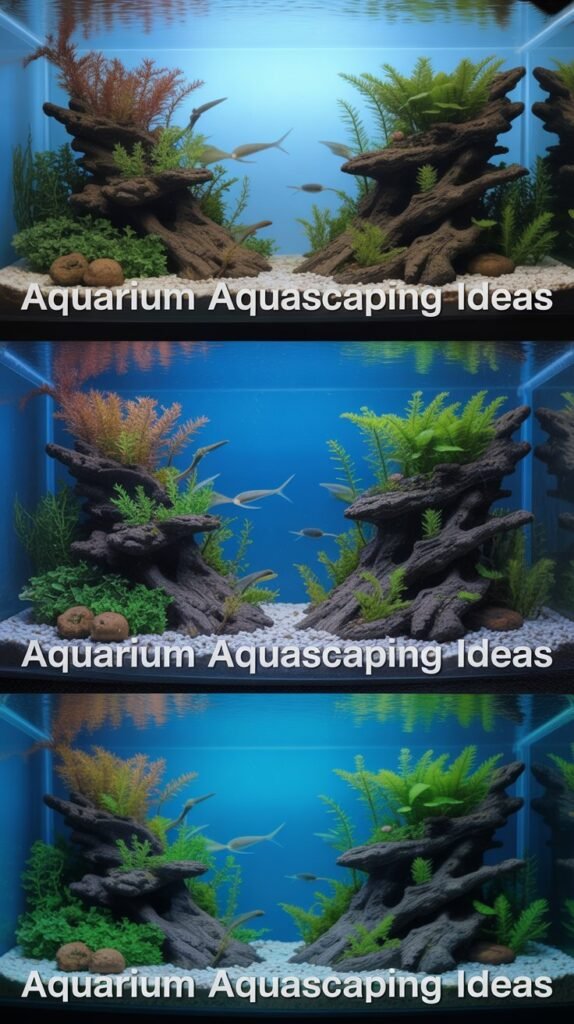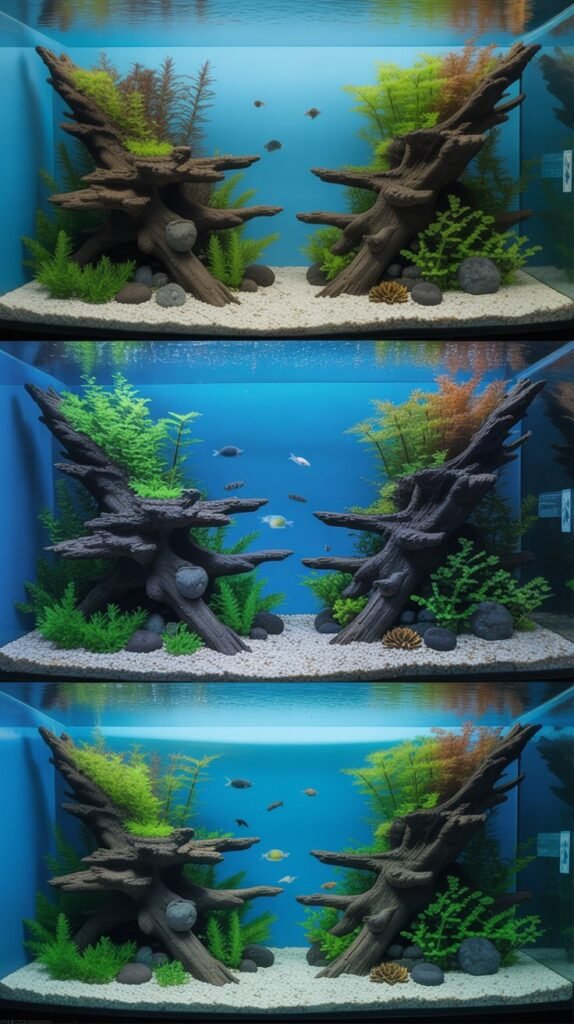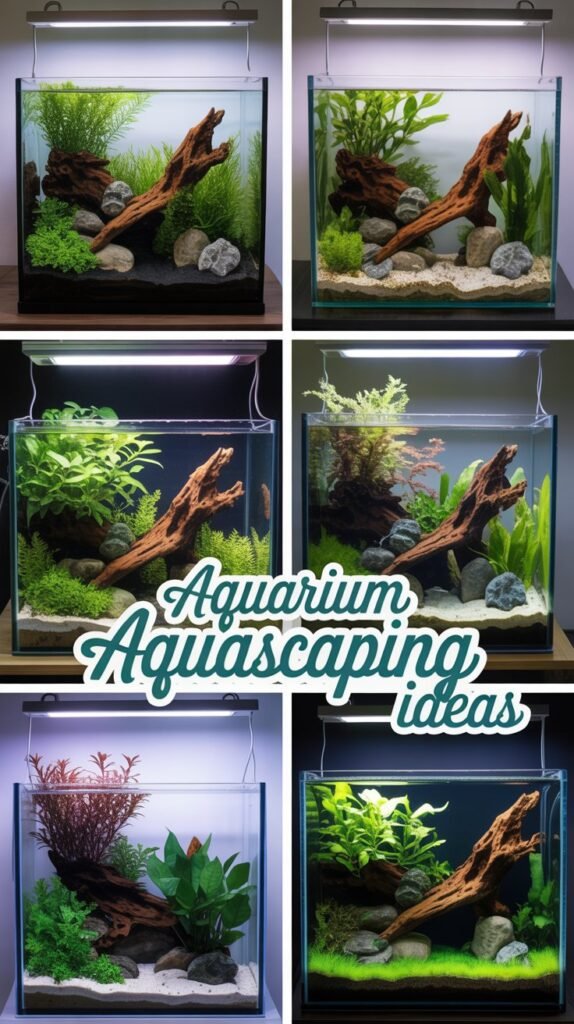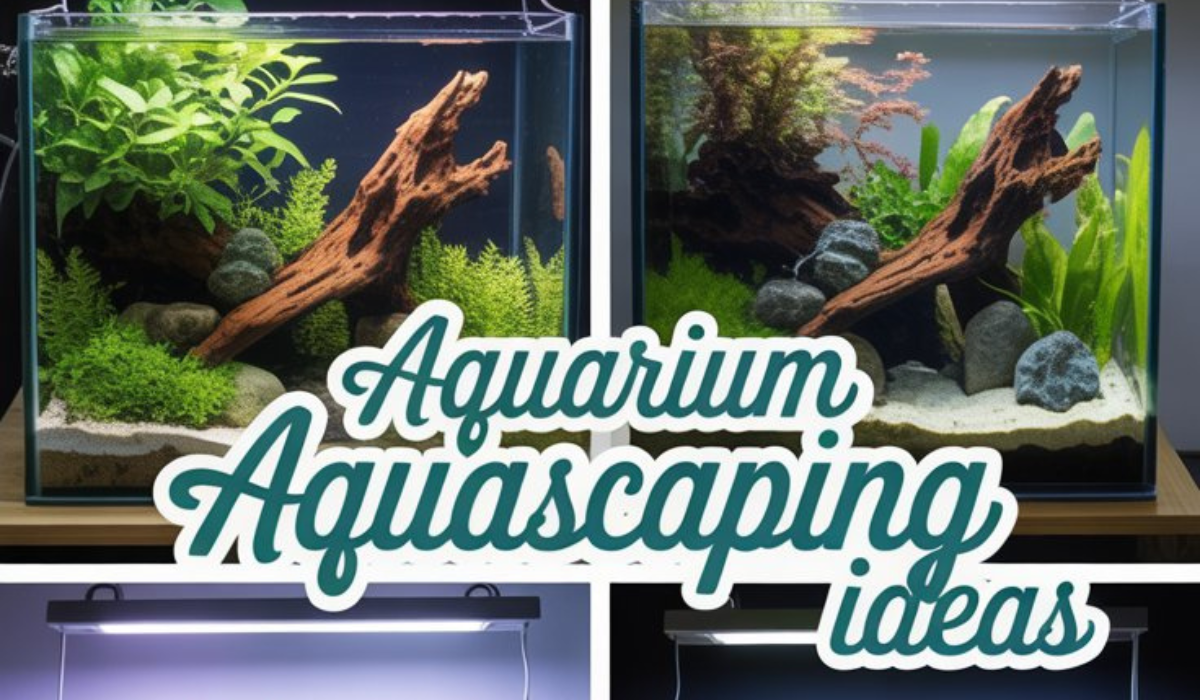Aquascaping is more than just placing plants and rocks in an aquarium — it’s the art of creating a living landscape underwater. Whether you’re inspired by lush jungles, serene mountain valleys, or minimalist Zen gardens, aquascaping allows you to express creativity while providing a healthy habitat for your aquatic life.
In this comprehensive guide, we’ll explore the best aquarium aquascaping ideas, popular styles, plant and hardscape combinations, setup techniques, and expert tips to create your dream tank. By the end, you’ll have all the inspiration and knowledge to design a stunning aquascape that thrives.
1. What Is Aquascaping?
Aquascaping is the process of designing and arranging aquatic plants, rocks, wood, and substrate in an aquarium to create an aesthetically pleasing and natural-looking underwater environment.
It combines artistic design with biological balance, aiming to build a scene that’s both visually striking and biologically sustainable.
A successful aquascape balances three key elements:
- Design: Composition, color, and symmetry.
- Biology: Plant growth, lighting, and nutrient balance.
- Harmony: Peaceful coexistence of plants, fish, and microorganisms.
2. Benefits of Aquascaping

Aquascaping isn’t just about beauty — it brings numerous benefits to your aquarium and your mental well-being:
- 🌿 Improved water quality: Live plants absorb toxins like ammonia, nitrates, and CO₂.
- 🧘 Stress relief: Watching a lush aquascape has calming effects and reduces anxiety.
- 🐟 Healthier fish: Natural shelters and oxygenated water improve fish well-being.
- 🎨 Creative outlet: It allows you to express artistry through natural design.
- 🌱 Eco-friendly ecosystem: Promotes a self-sustaining mini-ecosystem.
3. Essential Elements of Aquascaping
Before diving into aquascaping ideas, you need to understand its foundational components.
1. Substrate
The base layer that supports plant roots and defines the landscape.
Popular substrates include:
- Nutrient-rich soil: Ideal for planted tanks (e.g., ADA Aqua Soil, Fluval Stratum).
- Sand: Used for minimalist or river-style scapes.
- Gravel: Common in low-tech tanks.
2. Hardscape
Hardscape materials form the “skeleton” of your layout.
They include:
- Rocks (Seiryu, Dragon Stone, Lava Rock)
- Driftwood (Spider Wood, Mopani, Cholla)
3. Plants
Plants bring color and life. Choose based on light levels and maintenance needs:
- Foreground: Carpet plants (Monte Carlo, Dwarf Hairgrass)
- Midground: Cryptocoryne, Java Fern, Anubias
- Background: Vallisneria, Rotala, Hygrophila
4. Lighting
Lighting intensity determines plant health and color vibrancy. Use LED lights designed for planted tanks, such as Chihiros or Fluval Plant Spectrum.
5. CO₂ System
CO₂ injection promotes lush growth and deeper coloration, especially in high-tech aquascapes.
4. Popular Aquascaping Styles
Now, let’s explore the most inspiring aquarium aquascaping ideas based on style and theme.
1. Nature Aquarium Style
Inspired by: Forests, mountains, or meadows.
Created by: Takashi Amano, the father of modern aquascaping.
Nature aquariums mimic landscapes found in nature using driftwood, rocks, and plants arranged organically.
Key features:
- Natural, asymmetrical layout
- Use of mosses, ferns, and carpet plants
- Focus on harmony and realism
Ideal plants: Java Moss, Eleocharis, Cryptocoryne, Rotala
Fish: Tetras, Rasboras, Shrimp, Otocinclus
Pro tip: Use the “Golden Ratio” for composition — place focal points off-center for a more natural look.
2. Iwagumi Style

Inspired by: Japanese Zen gardens.
Focus: Simplicity, balance, and stone placement.
An Iwagumi aquascape uses stones as the main element, with plants serving as accents. It’s minimalist yet powerful.
Key features:
- Odd number of stones (usually 3 or 5)
- Foreground carpeting plants
- Open swimming space
Ideal plants: Dwarf Hairgrass, Glossostigma, Monte Carlo
Fish: Neon Tetras, Harlequin Rasboras, Amano Shrimp
Pro tip: Choose one “main stone” (Oyaishi) and smaller supporting stones (Fukuishi and Soeishi) to form natural flow.
3. Jungle Style Aquascape
Inspired by: Wild, untamed tropical forests.
Focus: Dense plant growth and organic chaos.
Jungle aquascapes emphasize height, texture, and density. It’s perfect for aquarists who love natural overgrowth.
Key features:
- Layered plants with different heights
- Minimal visible hardscape
- Shadows and dense canopies
Ideal plants: Amazon Sword, Java Fern, Vallisneria, Anubias
Fish: Angelfish, Gouramis, Discus
Pro tip: Use large-leaf plants at the back to create a sense of depth and wilderness.
4. Dutch Aquascape
Inspired by: European garden designs.
Focus: Color contrast and plant arrangement.
Dutch aquascapes are vibrant and structured — plants are arranged in “streets” or tiers of varying colors and heights.
Key features:
- No rocks or wood
- Use of 10+ plant species
- Emphasis on color gradients
Ideal plants: Ludwigia, Hygrophila, Rotala, Alternanthera
Fish: Neon Tetras, Rasboras, Guppies
Pro tip: Maintain clear foreground space to highlight plant layering.
5. Biotope Aquascape
Inspired by: Real-world habitats like the Amazon River or African lakes.
Focus: Authenticity and ecosystem accuracy.
Biotope aquascapes replicate the natural environment of specific fish species.
Examples:
- Amazon Biotope: Driftwood, sand, leaf litter, and Tetras
- African Cichlid Biotope: Rock formations with no plants
Ideal plants: Based on native regions
Fish: Species from the chosen habitat
Pro tip: Research the specific water parameters and decor of the habitat for realism.
6. Mountain or Cliff Style
Inspired by: Hills, cliffs, and valleys.
Focus: Vertical layouts and dramatic height.
Use stones and substrate slopes to mimic towering peaks.
Key features:
- Vertical rock formations
- Minimalist plant use
- Emphasis on depth and perspective
Ideal plants: Dwarf Hairgrass, Staurogyne Repens, Mosses
Fish: Schooling fish that emphasize scale, like Rummy Nose Tetras
Pro tip: Create slopes using lava rock beneath the substrate to maintain stability.
7. Island Aquascape
Inspired by: Isolated islands or underwater mounds.
Focus: Centralized composition.
This design uses one or multiple “islands” of plants and rocks surrounded by open sand.
Key features:
- Central mound layout
- Open foreground space
- 3D depth illusion
Ideal plants: Anubias, Cryptocoryne, Monte Carlo
Fish: Guppies, Shrimp, Rasboras
Pro tip: Keep background clear to highlight the main island focal point.
8. Riverbed Aquascape

Inspired by: Flowing rivers and natural streams.
Focus: Water movement and directional flow.
Riverbed aquascapes mimic the textures and direction of a flowing stream.
Key features:
- Pebbles, driftwood, and leaf litter
- Plants arranged in flow direction
- Natural, earthy tones
Ideal plants: Java Fern, Vallisneria, Bucephalandra
Fish: Loaches, Corydoras, Danios
Pro tip: Use curved sand paths to simulate water movement and add realism.
9. Minimalist or Zen Aquascape
Inspired by: Japanese simplicity and balance.
Focus: Space, calmness, and purity.
Minimalist tanks focus on few, perfectly placed elements and a sense of tranquility.
Key features:
- Sparse plants and rocks
- Negative space emphasis
- Clean lines and symmetry
Ideal plants: Anubias Nana Petite, Mosses, Dwarf Hairgrass
Fish: Betta, small Tetras, Shrimp
Pro tip: Use white sand or fine gravel to enhance minimal contrast.
5. Step-by-Step Guide to Creating Your Own Aquascape
Step 1: Plan Your Layout
Sketch your idea or use online aquascaping planners. Decide on style, focal point, and theme.
Step 2: Choose the Right Tank Size
Larger tanks (20+ gallons) offer more flexibility and visual depth.
Step 3: Add Substrate
Layer nutrient soil at the bottom and top with fine sand or gravel for aesthetics.
Step 4: Place Hardscape
Arrange rocks and driftwood according to your layout. Follow the Rule of Thirds for natural balance.
Step 5: Planting
- Start with background plants first.
- Then add midground and finally foreground carpet plants.
- Mist plants before filling with water to keep them hydrated.
Step 6: Fill the Tank
Slowly fill with dechlorinated water to avoid disturbing the substrate.
Step 7: Lighting and CO₂
Install LED lighting and CO₂ if using high-light plants.
Step 8: Cycling and Maintenance
Run the tank for 2–4 weeks to establish biological filtration before adding fish.
6. Maintenance Tips for a Healthy Aquascape
- Trim plants weekly to maintain shape and prevent overgrowth.
- Clean glass with algae scrapers or magnetic cleaners.
- Change 25–30% of water weekly.
- Dose fertilizers regularly (macro and micro nutrients).
- Check CO₂ and pH balance regularly.
7. Common Mistakes to Avoid
- Overcrowding: Too many plants or decorations reduce swimming space.
- Ignoring balance: Keep hardscape, plants, and fish in proportion.
- Wrong lighting: Either too weak (causes poor growth) or too strong (leads to algae).
- Skipping CO₂: High-demand plants will suffer without it.
- Poor maintenance: Algae and dead plant matter quickly ruin the look.
8. Budget-Friendly Aquascaping Ideas
You don’t need to spend hundreds of dollars to create a beautiful aquascape. Try these affordable ideas:
- Use local stones and driftwood (boil and clean first).
- Start with low-tech plants like Anubias, Java Fern, and Crypts.
- Skip CO₂ and use liquid carbon instead.
- Choose smaller tanks for easy maintenance.
9. Best Plants for Beginners
| Plant Name | Position | Light Level | CO₂ Required |
|---|---|---|---|
| Java Fern | Midground | Low | No |
| Anubias | Fore/Midground | Low | No |
| Cryptocoryne | Background | Medium | No |
| Dwarf Hairgrass | Foreground | High | Yes |
| Vallisneria | Background | Medium | No |
| Bucephalandra | Midground | Low | No |
10. Adding Fish to Your Aquascape
Choose fish that enhance your layout rather than overshadow it.
Best Fish for Aquascaping Tanks
- Neon Tetra
- Ember Tetra
- Harlequin Rasbora
- Otocinclus Catfish
- Amano Shrimp
- Betta (for minimalist setups)
Pro tip: Avoid large or aggressive fish that dig substrate or uproot plants.
11. Lighting Tips for Stunning Results
- Use 8–10 hours of light daily with a timer.
- Choose LEDs with a color temperature between 6,500K–8,000K.
- Adjust intensity based on plant types.
- Use “sunrise/sunset” dimming if available for natural effect.
12. Advanced Aquascaping Techniques
- Depth illusion: Use smaller rocks and plants toward the back.
- Perspective lines: Create paths or slopes to draw the eye inward.
- Contrast: Combine light sand with dark stones for visual drama.
- Texture variety: Mix leaf shapes and sizes for natural realism.
13. Inspiring Aquascaping Ideas for Every Tank Size
Small Tanks (5–10 Gallons):
- Iwagumi-style with a few rocks and carpeting plants.
- Betta-friendly minimalist scape.
Medium Tanks (20–40 Gallons):
- Nature-style forest layout.
- Riverbed with driftwood roots and sand paths.
Large Tanks (50+ Gallons):
- Dutch aquascape with plant terraces.
- Jungle or mountain theme with dramatic slopes.
14. Aquascaping Tools You’ll Need
- Aquascaping tweezers
- Curved scissors
- Substrate spatula
- Gravel vacuum
- Spray bottle
- Algae scraper
These tools make planting, trimming, and cleaning easier and more precise.
15. The Future of Aquascaping
Modern aquascaping continues to evolve with:
- 3D backgrounds and rock molds
- AI-controlled lighting and CO₂ systems
- Self-sustaining eco tanks
- Nano aquascaping — creating miniature underwater worlds in tiny tanks
Conclusion
Aquarium aquascaping is both science and art — a creative way to bring nature into your home while supporting aquatic life. Whether you prefer the serenity of an Iwagumi, the color of a Dutch garden, or the realism of a Nature Aquarium, each design reflects your personality and passion.
With the right balance of plants, rocks, lighting, and maintenance, your aquarium can become a breathtaking underwater masterpiece — one that not only captivates viewers but also creates a healthy, thriving environment for your fish.
FAQs About Aquarium Aquascaping Ideas
1. What is the easiest aquascaping style for beginners?
The Nature Aquarium or Iwagumi style is perfect for beginners — simple to design and maintain.
2. Do I need CO₂ for aquascaping?
Not always. Low-tech plants like Java Fern and Anubias thrive without CO₂, but CO₂ enhances growth and color in demanding species.
3. How long does it take for plants to grow in an aquascape?
Most plants take 3–6 weeks to establish. Carpet plants may take longer, depending on lighting and CO₂.
4. How often should I trim aquascape plants?
Trim every 1–2 weeks to maintain shape and prevent overgrowth.
5. What fish are best for planted aquascapes?
Peaceful species like Tetras, Rasboras, Shrimp, and Otocinclus are ideal as they don’t damage plants.
6. Can I use fake plants in aquascaping?
Yes, but live plants look more natural and improve water quality.
7. What is the best substrate for aquascaping?
Use nutrient-rich soil like ADA Aqua Soil or Fluval Stratum for healthy plant roots.
8. Can I combine different aquascaping styles?
Yes, hybrid aquascapes are popular — such as combining Iwagumi with Nature elements.
9. How do I prevent algae in aquascapes?
Maintain proper lighting, avoid overfeeding, and add algae eaters like Amano Shrimp.
10. Is aquascaping expensive?
It can be as affordable or advanced as you choose. Start small with low-tech setups and upgrade gradually.

